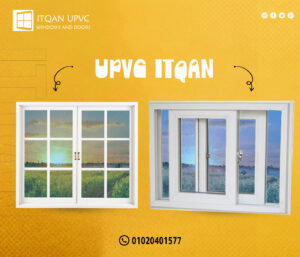UPVC Windows and Sustainability: In the realm of sustainable living and eco-friendly construction, every choice counts. From energy-efficient appliances to renewable building materials, individuals and industries alike are increasingly turning to options that reduce environmental impact without compromising quality or aesthetics. In this context, UPVC (Unplasticized Polyvinyl Chloride) windows have emerged as a frontrunner, offering a compelling blend of durability, energy efficiency, and sustainability. Let’s delve into why UPVC windows represent the green choice in the realm of construction and design.
Understanding UPVC Windows
UPVC, a type of plastic, is known for its resilience and versatility. Unlike traditional PVC, UPVC does not contain plasticizers, making it rigid and durable. These properties make it an ideal material for windows, doors, and other building components.
1. Durability:
One of the key factors contributing to the sustainability of UPVC windows is their durability. Unlike traditional wooden frames, UPVC windows are resistant to rot, corrosion, and decay. This longevity means that UPVC windows have a significantly longer lifespan, reducing the need for frequent replacements and the associated resource consumption.
2. Energy Efficiency:
UPVC windows are excellent insulators, helping to maintain comfortable indoor temperatures while reducing the need for excessive heating or cooling. The insulation properties of UPVC windows contribute to lower energy bills and reduced carbon emissions associated with heating and cooling homes and buildings. Additionally, the tight seals of UPVC windows prevent drafts, further enhancing energy efficiency.
3. Low Maintenance:
UPVC windows require minimal maintenance compared to their wooden counterparts. Unlike wood, UPVC does not need to be sanded, painted, or treated regularly to maintain its appearance and structural integrity. This translates to fewer resources expended over the lifetime of the windows, making UPVC a sustainable choice for environmentally conscious consumers.
Environmental Benefits
Beyond their practical advantages, UPVC windows offer several environmental benefits:
1. Recyclability:
UPVC is a highly recyclable material. At the end of their lifespan, UPVC windows can be recycled to produce new products, reducing the demand for virgin materials and minimizing waste sent to landfills. This closed-loop recycling process contributes to a circular economy and reduces the environmental footprint of window manufacturing.
2. Reduced Carbon Footprint:
The energy efficiency of UPVC windows directly translates to a reduced carbon footprint. By minimizing energy consumption for heating and cooling, UPVC windows help mitigate greenhouse gas emissions associated with fossil fuel use. Additionally, the durability and recyclability of UPVC further contribute to its low environmental impact over its lifecycle.In a world increasingly focused on sustainability, UPVC windows stand out as a green choice for environmentally conscious consumers and builders. With their durability, energy efficiency, low maintenance requirements, and recyclability, UPVC windows offer a compelling combination of environmental benefits and practical advantages. By opting for UPVC windows, individuals and industries alike can contribute to a more sustainable future while enjoying the comfort, aesthetics, and performance of high-quality window solutions.
The Future of Sustainable Construction
As society continues to prioritize sustainability and environmental stewardship, the demand for eco-friendly building materials like UPVC windows is expected to grow. Architects, builders, and homeowners are increasingly incorporating sustainability into their design and construction practices, seeking solutions that reduce environmental impact without compromising quality or performance.
1. Innovation in Manufacturing:
The ongoing innovation in UPVC manufacturing processes holds promise for further reducing the environmental footprint of these windows. Advancements in recycling technologies, such as improved methods for reclaiming and processing UPVC, can enhance the sustainability of UPVC windows by minimizing waste and energy consumption during production.
2. Design Integration:
The versatility of UPVC allows for seamless integration into various architectural styles and building designs. As sustainability becomes an integral aspect of design considerations, UPVC windows offer designers and homeowners flexibility without sacrificing aesthetics. From sleek modern designs to traditional aesthetics, UPVC windows can complement a wide range of architectural visions.
3. Regulatory Support:
Government initiatives and building codes increasingly prioritize energy efficiency and environmental sustainability. In many regions, incentives and regulations encourage the use of energy-efficient building materials like UPVC windows. These policies not only drive market demand but also incentivize manufacturers to invest in sustainable practices and product innovation.
4. Consumer Awareness:
As awareness of environmental issues grows, consumers are becoming more discerning about the products they choose for their homes and buildings. UPVC windows offer a compelling value proposition for environmentally conscious consumers seeking sustainable solutions without compromising on performance or aesthetics. Educating consumers about the benefits of UPVC windows can further drive adoption and support sustainable practices in the construction industry.UPVC windows represent a significant step forward in sustainable construction practices.

Overcoming Challenges and Addressing Concerns
While UPVC windows offer numerous environmental benefits, it’s essential to address potential challenges and concerns associated with their use:
1. Thermal Expansion:
UPVC has a higher coefficient of thermal expansion compared to materials like aluminum or wood. This characteristic can lead to issues such as warping or distortion under extreme temperature fluctuations. However, advancements in UPVC window design and manufacturing techniques have mitigated many of these concerns, ensuring long-term durability and performance.
2. Disposal:
Although UPVC is highly recyclable, proper disposal and recycling infrastructure must be in place to realize its full environmental potential. Efforts to improve collection systems and recycling facilities for UPVC materials are essential to maximize resource recovery and minimize waste.
3. Chemical Additives:
While UPVC itself is inert and non-toxic, concerns have been raised about the additives used during manufacturing, such as stabilizers and plasticizers. However, many manufacturers offer UPVC formulations that minimize or eliminate the use of harmful additives, ensuring that UPVC windows meet stringent environmental and health standards.
4. Lifecycle Assessment:
A comprehensive lifecycle assessment is crucial for evaluating the overall environmental impact of it, taking into account factors such as raw material extraction, manufacturing processes, transportation, use, and end-of-life disposal. By conducting thorough assessments, stakeholders can identify areas for improvement and optimize sustainability across the entire product lifecycle.
Collaborative Efforts for a Sustainable Future
Addressing these challenges requires collaboration among industry stakeholders, policymakers, researchers, and consumers. By working together, we can foster innovation, promote sustainable practices, and overcome barriers to the widespread adoption of it and other eco-friendly building materials.
1. Research and Development:
Investment in research and development is essential for advancing UPVC technology, optimizing manufacturing processes, and developing new materials with even greater sustainability benefits. By supporting research initiatives, governments, industry associations, and academic institutions can drive innovation and accelerate the transition to a more sustainable built environment.
2. Education and Outreach:
Educating consumers, architects, builders, and policymakers about the environmental benefits of it is crucial for fostering demand and driving market adoption. Outreach efforts, such as sustainability certifications, educational campaigns, and industry events, can raise awareness and promote the advantages of it in sustainable construction.
3. Policy Support:
Governments can play a significant role in promoting the use of it and other sustainable building materials through incentives, regulations, and procurement policies. By offering tax incentives, rebates, and subsidies for energy-efficient building products, policymakers can encourage investment in sustainable infrastructure and accelerate market uptake.

